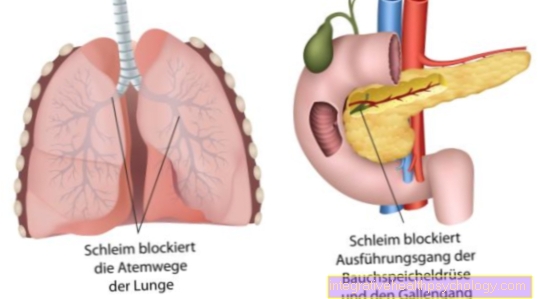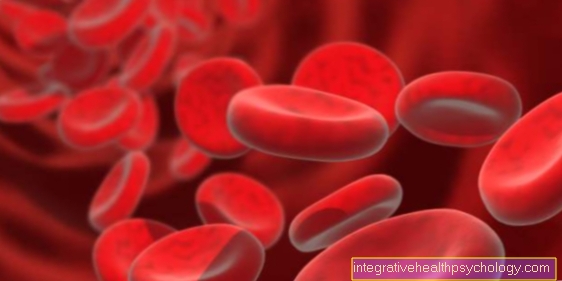What is the life expectancy with liver cirrhosis?
introduction
Cirrhosis of the liver is a life-threatening, permanent disease of the liver that can be triggered by various underlying chronic diseases. The most important causes of liver cirrhosis are alcoholic or non-alcoholic fatty liver disease, as well as liver inflammation such as viral hepatitis diseases. The liver tissue is transformed into cirrhotic connective tissue as a result of chronic inflammatory processes, which leads to a slowly progressive loss of function of the organ. Life expectancy depends on many factors, living conditions and also coincidences. In principle, liver disease in the very early stages can be associated with almost no impairment of life expectancy, while advanced liver failure can be fatal every day.

What is the life expectancy with liver cirrhosis?
The general life expectancy in cirrhosis of the liver is very variable and can range from no restriction compared to the normal population to a daily life-threatening disease. Life expectancy depends on the remaining function of the liver and the compensation of the damaged organ areas. Life expectancy can be estimated using the so-called “Child-Pugh classification”. This is calculated from various parameters, which include the synthesis and production functions but also the filtration functions of toxic substances. A reduction in life expectancy can only be assumed if the albumin level and coagulation values decrease significantly, as well as an increase in toxic products such as bilirubin or ammonia. In the so-called “final stage”, the “Child C” stage of the disease, there is an average life expectancy of 35% per year. At this stage, it is a threatening clinical picture that can decompensate at any time and cause complications.
You might also be interested in this topic: This is what end-stage liver cirrhosis looks like
This has a positive effect on life expectancy with cirrhosis of the liver
Liver cirrhosis is a very variable disease, as it can be associated with very different forms and with various secondary diseases and complications. The onset of cirrhosis of the liver usually does not lead to any physical restrictions, as the healthy parts of the liver can sufficiently compensate for the filtering and production functions of the cirrhotic liver. The severity of liver cirrhosis can be estimated using a classification that includes various body functions that are dependent on liver function. In the early stages of the disease, the average life expectancy is not restricted. However, this still depends on various factors. In addition to the stage, the underlying underlying disease is of enormous importance for the progression of liver cirrhosis. The progression of liver cirrhosis can only be stopped with treatment and elimination of the cause. Refraining from alcohol is an important factor in therapy. With advanced liver cirrhosis, life expectancy depends primarily on the occurrence of dangerous complications. A good coagulation function of the blood, a low pressure of the blood vessels in the liver, a sufficient production of vital proteins, as well as a remaining filter function of the liver are important factors in avoiding liver-related complications.
Read more on the subject at: Changes in blood values in cirrhosis of the liver
This has a negative impact on life expectancy in the case of liver cirrhosis
The life expectancy of liver cirrhosis depends largely on the remaining liver function and the resulting complications and secondary diseases. The beginning of liver cirrhosis can be physically compensated for by the healthy liver parts, but it progresses quickly if the underlying disease continues to attack the liver. Adverse factors for the health of the liver tissue are heavy alcohol consumption, a high-fat diet and an unhealthy lifestyle, as well as active liver inflammation of various causes. Serious complications that lead to a severe loss of health arise from bleeding, large amounts of ascites or brain damage from unfiltered toxic substances in the blood. A “Quick value” that is reduced in the laboratory value represents a risk of severe bleeding, which can occur with increased pressure in the blood vessels in liver cirrhosis. Other factors with unfavorable prognosis are large amounts of ascites, decreased albumin and increased bilirubin levels in the blood, as well as limitations due to brain damage. Externally recognizable effects of cirrhosis of the liver may include yellowing of the skin and eyes or a widening of the superficial veins on the trunk.
What is the life expectancy with decompensated cirrhosis of the liver?
Even advanced liver cirrhosis can often be symptom-free, as the healthy parts of the liver can sufficiently compensate for the missing functions. Only when a large part of the liver tissue has been destroyed by liver cirrhosis does so-called "decompensations" occur, which can be seen as a change in laboratory values, due to heavy bleeding, accumulation of ascites, the occurrence of infections or acute complications of the kidneys or the brain and the lungs. With the severity of the cirrhosis and the progressive loss of liver function, the decompensations and complications become more severe. In most cases, fatal consequences of liver cirrhosis also result from acute decompensations. Frequent causes of death are infections or bleeding. Life expectancy drops sharply with the occurrence of severe decompensations, whereby acute complications and survival are difficult to predict and estimate. In stage “Child C” of liver cirrhosis, several decompensations per year can generally be assumed, which is why the average overall survival probability for one year at this stage is around 35%. However, disease patterns that are significantly more stable or with more complications can also be present within this stage.
A properly composed menu and avoiding certain products can increase your life expectancy with cirrhosis of the liver. Learn more about this at: Diet in cirrhosis of the liver
Water in the stomach
Water in the abdomen, also called "ascites", is a typical symptom of advanced liver cirrhosis. This is due to a decrease in the albumin level in the blood, which is an important criterion for liver cirrhosis. Albumin is a protein produced by the liver that binds the water in the blood vessels. If the body is lowered, the water can escape from the blood vessel into the surrounding tissue or into the abdominal cavity in several places. The ascites can be therapeutically suctioned off, but this can lead to life-threatening fluctuations in the electrolyte balance. Ascites suggests an advanced stage of liver cirrhosis in which life expectancy is already reduced.
Also read our topic: Water in the stomach





























